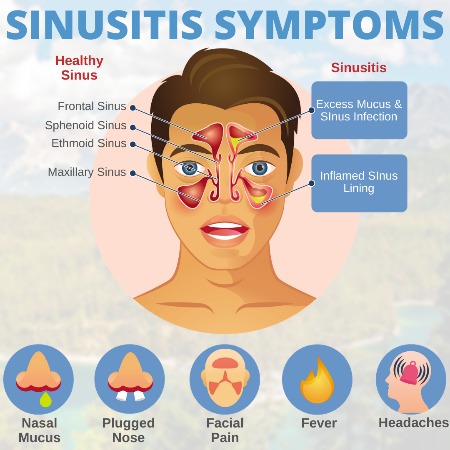Respiratory Disorders

Respiratory Disorders

What Is Tonsillitis?
Tonsillitis is an infection of your tonsils, it is inflammation of the tonsils, two oval-shaped pads of tissue at the back of the throat
Signs & Symptoms Of Tonsilitis
- Throat pain or tenderness
- Fever
- Red tonsils
- A white or yellow coating on your tonsils
- Painful blisters or ulcers on your throat
- Headache
- Loss of appetite
- Ear pain
- Trouble swallowing
- Swollen glands in your neck or jaw
- Fever and chills
- Bad breathe
- A scratchy or muffled voice
- Stiff neck
The main symptoms of tonsillitis are inflamed and swollen tonsils, sometimes severe enough to make it hard to breathe through your mouth. Other symptoms include:

What Is Sinusitis?
Sinusitis is an inflammation, or swelling, of the tissue lining the sinuses. Sinuses are hollow spaces within the bones between your eyes, behind your cheekbones, and in your forehead. They make mucus, which keeps the inside of your nose moist. That, in turn, helps protect against dust, allergens, and pollutants.
Healthy sinuses are filled with air. But when they become blocked and filled with fluid, germs can grow and cause an infection.
Signs & Symptoms of Sinusitis
- Postnasal drip (mucus dripping down your throat).
- Runny nose with thick yellow or green mucus.
- Stuffy nose.
- Facial pressure (particularly around your nose, eyes, and forehead). This might get worse when you move your head around or bend over.
- Pressure or pain in your teeth.
- Ear pressure or pain.
- Fever.
- Bad breath or a bad taste in your mouth.
- Cough.
- Headache.
- Tiredness.

What Is Bronchitis?
Bronchitis is a condition that develops when the airways in the lungs, called bronchial tubes, become inflamed and cause coughing, often with mucus production. Bronchitis can be acute (short-term) or chronic (long-term).
Signs & Symptoms of Bronchitis
- Chest congestion, when your chest feels full or clogged.
- A cough that may bring up mucus that’s clear, white, yellow, or green.
- Shortness of breath.
- Wheezing or a whistling sound when you breathe.
- Body aches and chills.
- Feeling “wiped out”.
- Low fever.
- Runny, stuffy nose.
- Sore throat.

What Is Allergic Rhinitis?
Allergic rhinitis, also called hay fever, is an allergic reaction to tiny particles in the air called allergens. When you breathe in allergens through your nose or mouth, your body reacts by releasing a natural chemical called histamines which causes sneezing, congestion, itchy nose, and watery eyes. Pollen, pet dander, and insects can lead to hay fever symptoms.
Signs & Symptoms of Allergic Rhinitis
- Nasal stuffiness (congestion), sneezing, and runny nose.
- Itchy nose, throat, and eyes.
- Red or watery eyes.
- Headaches, sinus pressure, and dark circles under your eyes.
- More mucus in your nose and throat.
- Tiredness.
- Sore throat from mucus dripping down your throat (post-nasal drip).
- Wheezing, coughing, and trouble breathing.

What Is Asthma?
Asthma is a condition in which your airways narrow and swell and may produce extra mucus. This can make breathing difficult and trigger coughing, a whistling sound (wheezing) when you breathe out and shortness of breath.
Signs & Symptoms of Asthma
- Shortness of breath.
- Chest tightness or pain.
- Wheezing when exhaling, which is a common sign of asthma in children.
- Trouble sleeping caused by shortness of breath, coughing, or wheezing.
- Coughing or wheezing attacks that are worsened by a respiratory virus, such as a cold or the flu.
Signs that Your Asthma May Be Worsening
- Asthma signs and symptoms that are more frequent and bothersome.
- Increasing difficulty breathing, as measured with a device used to check how well your lungs are working (peak flow meter).
- The need to use a quick-relief inhaler more often.
Situational Triggers for Asthma
- Exercise-induced asthma, which may be worse when the air is cold and dry.
- Occupational asthma, triggered by workplace irritants such as chemical fumes, gases, or dust.
- Allergy-induced asthma, triggered by airborne substances, such as pollen, mild spores, cockroach waste, or particles of skin and dried saliva shed by pets (pet dander).

What Is Laryngitis?
Laryngitis is an inflammation of your voice box (larynx) from overuse, irritation, or infection.
Signs & Symptoms of Laryngitis
- A sore throat or raw throat.
- A tickling feeling in your throat.
- A low-grade fever.
- Hoarseness.
- Trouble speaking or loss of voice.
- A dry cough.
- A constant urge to clear your throat.
- Swollen glands.
- A dry throat.

What Are Viral Infections?
Viral infections are illnesses you get from tiny organisms that use your cells to make more copies of themselves (viruses). Viral infections commonly cause respiratory and digestive illnesses, but viruses can also infect most other parts of your body.
Signs & Symptoms of Viral Infection
- Cough.
- Fever.
- Hoarse voice.
- Fatigue and lack of energy.
- Red eyes.
- Runny nose.
- Sore throat.
- Swollen lymph nodes (swelling on the sides of your neck).
